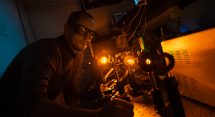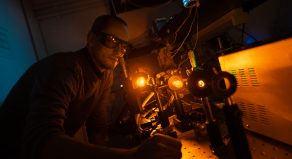Macquarie University researchers have developed an improved laser system that will help large optical telescopes to gather more accurate data.

Diamond Raman laser. Image by Joanne Stephan
Large-diameter ground-based optical telescopes now routinely use laser-beam generated artificial guide stars, created in the higher levels of the atmosphere. These artificial stars allow users to correct atmospheric aberrations of light passing to and from space, using . They are crucial for high fidelity transmission of data for applications in both optical free-space and ground to earth communications, in space debris imaging and tracking, and for astronomy.
The principle involves using a precisely tuned laser to energise atoms in the sodium layer that occurs naturally in the mesosphere, at an altitude of around 90 km. These atoms re-emit the laser light, temporarily creating a glowing artificial star. There have been a number of technologies developed to do this, but generating that specific wavelength has been a notorious challenge that has so far needed impractical approaches.
Now researchers from the MQ Photonics Research Centre at Macquarie University have shown that diamond Raman lasers are a highly efficient way to generate the precise output needed. They have for the first time demonstrated a continuous-wave 589 nm diamond laser for guidestar applications. Described in , the laser delivered higher power and efficiency than previous guide star laser systems of its type.

Diamond Raman laser. Image by Joanne Stephan
These characteristics are already competitive with other approaches, but the real significance of the result is that the technology can be further developed to increase the quality of future guide stars. Diamond can dissipate heat rapidly, and is less prone to unwanted optical distortions. This combination provides a pathway towards producing more powerful guide star beams. The researchers predict that its extra flexibilities, such as delivering the laser power as a series of microsecond optical pulses, will also be a benefit for adaptive optical systems. As well as power scaling, the diamond sodium laser concept is promising for generating microsecond duration pulsed output with simultaneous high peak power and average power, to enable more point-like stars to be generated through adaptive optic systems, along with other enhancements.
“The applications need brighter guide stars with reduced star elongation and background noise, and these are aspects that our diamond laser approach looks like being able to address,” says Dr Xuezong Yang, lead experimentalist on the project. “Our approach is also highly practical, because as the intrinsic gain properties of the diamond element mean the laser is found to run on a single narrow frequency. This keeps our design simple, and the device potentially robust and low-cost.”
The diamond laser is in the class of lasers called Raman lasers, and works by stimulated scattering rather than stimulated emission. The researchers have found that this core difference enables the laser to operate more stably on a pure single frequency.
The authors believe we will soon see diamond lasers on telescopes and at higher levels. “We believe that the diamond approach will provide an interesting system for greatly expanding the brightness and quality of future guide stars. The light-atom interaction in the sodium layer happens to be extremely complex, but this brings forth interesting opportunities to adapt lasers to boost the performance of earth-to-space adaptive optical systems.” says Professor Rich Mildren, the research leader for this work.







